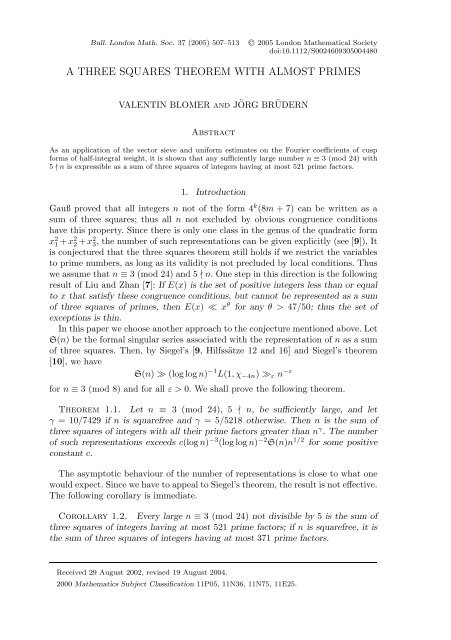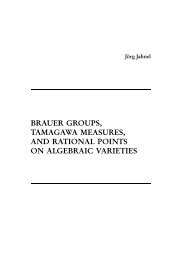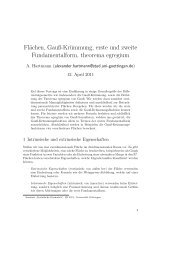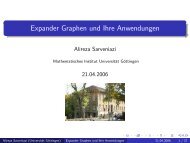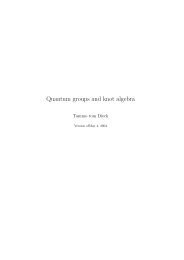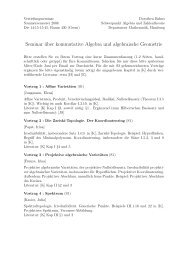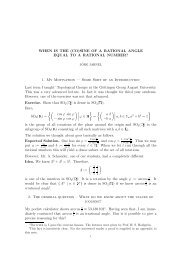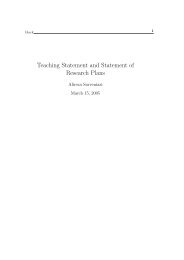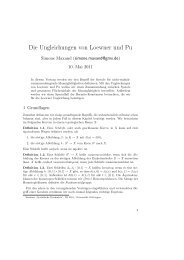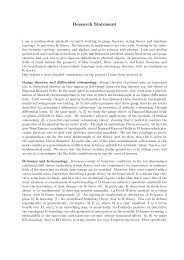a three squares theorem with almost primes - Mathematisches Institut
a three squares theorem with almost primes - Mathematisches Institut
a three squares theorem with almost primes - Mathematisches Institut
Create successful ePaper yourself
Turn your PDF publications into a flip-book with our unique Google optimized e-Paper software.
Bull. London Math. Soc. 37 (2005) 507–513<br />
C❡ 2005 London Mathematical Society<br />
doi:10.1112/S0024609305004480<br />
A THREE SQUARES THEOREM WITH ALMOST PRIMES<br />
VALENTIN BLOMER and JÖRG BRÜDERN<br />
Abstract<br />
As an application of the vector sieve and uniform estimates on the Fourier coefficients of cusp<br />
forms of half-integral weight, it is shown that any sufficiently large number n ≡ 3 (mod 24) <strong>with</strong><br />
5 ∤ n is expressible as a sum of <strong>three</strong> <strong>squares</strong> of integers having at most 521 prime factors.<br />
1. Introduction<br />
Gauß proved that all integers n not of the form 4 k (8m + 7) can be written as a<br />
sum of <strong>three</strong> <strong>squares</strong>; thus all n not excluded by obvious congruence conditions<br />
have this property. Since there is only one class in the genus of the quadratic form<br />
x 2 1 + x 2 2 + x 2 3, the number of such representations can be given explicitly (see [9]). It<br />
is conjectured that the <strong>three</strong> <strong>squares</strong> <strong>theorem</strong> still holds if we restrict the variables<br />
to prime numbers, as long as its validity is not precluded by local conditions. Thus<br />
we assume that n ≡ 3 (mod 24) and 5 ∤ n. One step in this direction is the following<br />
result of Liu and Zhan [7]: If E(x) is the set of positive integers less than or equal<br />
to x that satisfy these congruence conditions, but cannot be represented as a sum<br />
of <strong>three</strong> <strong>squares</strong> of <strong>primes</strong>, then E(x) ≪ x θ for any θ>47/50; thus the set of<br />
exceptions is thin.<br />
In this paper we choose another approach to the conjecture mentioned above. Let<br />
S(n) be the formal singular series associated <strong>with</strong> the representation of n as a sum<br />
of <strong>three</strong> <strong>squares</strong>. Then, by Siegel’s [9, Hilfssätze 12 and 16] and Siegel’s <strong>theorem</strong><br />
[10], we have<br />
S(n) ≫ (log log n) −1 L(1,χ −4n ) ≫ ε n −ε<br />
for n ≡ 3 (mod 8) and for all ε>0. We shall prove the following <strong>theorem</strong>.<br />
Theorem 1.1. Let n ≡ 3 (mod 24), 5 ∤ n, be sufficiently large, and let<br />
γ =10/7429 if n is squarefree and γ =5/5218 otherwise. Then n is the sum of<br />
<strong>three</strong> <strong>squares</strong> of integers <strong>with</strong> all their prime factors greater than n γ . The number<br />
of such representations exceeds c(log n) −3 (log log n) −2 S(n)n 1/2 for some positive<br />
constant c.<br />
The asymptotic behaviour of the number of representations is close to what one<br />
would expect. Since we have to appeal to Siegel’s <strong>theorem</strong>, the result is not effective.<br />
The following corollary is immediate.<br />
Corollary 1.2. Every large n ≡ 3 (mod 24) not divisible by 5 is the sum of<br />
<strong>three</strong> <strong>squares</strong> of integers having at most 521 prime factors; if n is squarefree, it is<br />
the sum of <strong>three</strong> <strong>squares</strong> of integers having at most 371 prime factors.<br />
Received 29 August 2002, revised 19 August 2004.<br />
2000 Mathematics Subject Classification 11P05, 11N36, 11N75, 11E25.
508 valentin blomer and jörg brüdern<br />
By working along the lines proposed by Tolev [11], it is possible to reduce the<br />
number of prime factors in this corollary.<br />
Corollary 1.3. Every sufficiently large n ≡ 3 (mod 24) not divisible by 5 is<br />
the sum of <strong>three</strong> <strong>squares</strong> of squarefree numbers.<br />
This is also clear, since only a small proportion of the representations obtained<br />
by the <strong>theorem</strong> can have non-squarefree variables:<br />
∑ ∑<br />
1 ≪ ∑ ∑ ∑<br />
1<br />
n γ pn 1/ 2<br />
x 2 1 +x2 2 +x2 3 =n<br />
x 1≠0, p 2 |x 1<br />
pn γ<br />
≪ n ε ∑<br />
0
a <strong>three</strong> <strong>squares</strong> <strong>theorem</strong> <strong>with</strong> <strong>almost</strong> <strong>primes</strong> 509<br />
and let<br />
o(f) =#{T ∈ SL 3 (Z) :T t AT = A}<br />
be the (finite) number of automorphs of f. As usual, we define the weighted means<br />
( ∑<br />
) −1<br />
1 ∑ r(<br />
r(gen f,n) :=<br />
˜f,n)<br />
o( ˜f)<br />
o( ˜f)<br />
˜f∈gen f<br />
˜f∈genf<br />
and<br />
( ∑<br />
) −1<br />
1 ∑ r(<br />
r(spn f,n) :=<br />
˜f,n)<br />
o( ˜f)<br />
o( ˜f) ,<br />
˜f∈spn f<br />
˜f∈spn f<br />
where the summations are taken over a set of representatives of all classes in the<br />
genus and the spinor genus of f, respectively (see [8], Section 102). By a well-known<br />
result of Siegel [9], r(gen f,n) is the product of all local densities. It turns out that<br />
r(spn f,n) is a good approximation to r(f,n).<br />
Lemma 2.1. Let f be a positive definite ternary quadratic form of level N.<br />
Then, for any ε>0 and odd n, wehave:<br />
r(spn f,n) − r(f,n) ≪ ε N 45/28 n 13/28+ε ,<br />
uniformly in N n 1/2 . For squarefree n, wehave<br />
r(spn f,n) − r(f,n) ≪ ε Nn 13/28+ε ,<br />
uniformly in N n 1/2 .<br />
Lemma 2.1 is part of [1, Theorem 1], and implies the following result, which is<br />
the analogue of [2, Theorem 3].<br />
Lemma 2.2. Let n ≡ 3 (mod 8), and let A d , S(n) and ω(d) be as above. Set<br />
θ 0 =1/252 if n is squarefree, and θ 0 =1/354 otherwise. Define the real numbers<br />
R(n, d) by the equation<br />
|A d | = ω(d,n) π<br />
d 1 d 2 d 3 4 S(n)n1/2 + R(n, d).<br />
Then, whenever 0
510 valentin blomer and jörg brüdern<br />
3. Local computations<br />
To apply the vector sieve, we have to study the behaviour of ω. Thiscanbe<br />
done similarly as in [2, pp. 75–78], so we content ourselves <strong>with</strong> a rough outline. It<br />
turns out that in the ternary case, ω behaves somewhat more irregularly than in<br />
the quaternary case. Let S(q, a) = ∑ q<br />
x=1 e(ax2 /q), let<br />
q∑<br />
( ) −an<br />
A(q, d,n)=q −3 S(q, ad 2 1)S(q, ad 2 2)S(q, ad 2 3)e ,<br />
q<br />
and let<br />
a=1<br />
(a,q)=1<br />
χ p (n, d) =<br />
∞∑<br />
A(p k , d,n)<br />
k=0<br />
be the local densities. We write e 1 (p) =(p, 1, 1), e 2 (p) =(p, p, 1), e 3 (p) =(p, p, p)<br />
∏<br />
and ω ν (p) := ω(e ν (p)) for 1 ν 3. Let µ(d) 2 = 1. Then, since S(n, d) =<br />
p χ p(n, d) andA(p k , d,n)=A(p k , e ν (p),n)forp ν ‖ d 1 d 2 d 3 ,wehave<br />
ω(d) =<br />
∏<br />
p ν ‖d 1d 2d 3<br />
ν1<br />
χ p (n, e ν (p))<br />
χ p (n, (1, 1, 1)) =<br />
It is clear that ω ν (2) = 0 for ν 1andn ≡ 3 (mod 8).<br />
∏<br />
p ν ‖d 1d 2d 3<br />
ν1<br />
ω ν (p).<br />
Lemma 3.1. Let p be odd. If p ∤ n, then<br />
ω 1 (p) = p − ( )<br />
−1<br />
p<br />
p + ( −n<br />
), ω 2 (p) = p( 1+ ( ))<br />
n<br />
p<br />
p<br />
p + ( )<br />
−n<br />
, ω 3 (p) =0.<br />
p<br />
If p θ ‖ n <strong>with</strong> θ 1, then<br />
ω 1 (p) = 1+( −1<br />
p<br />
) p−1<br />
p<br />
1+f θ (p)<br />
+ pf θ (p)<br />
, ω 2 (p) = 1+p2 f θ (p)<br />
1+f θ (p) , ω 3(p) = p + p3 f θ (p)<br />
1+f θ (p) ,<br />
where f θ is defined as follows.<br />
(i) If θ is odd, put f θ (p) =p −1 − p −(θ+1)/2 − p −(θ+3)/2 .<br />
(ii) If θ is even, put<br />
( ) −np<br />
f θ (p) =p −1 − p −(θ+2)/2 −θ<br />
+<br />
p −(θ+2)/2 .<br />
p<br />
Proof. In the case where p ∤ n, wehave<br />
p 2 χ p (n, d) =#{x ∈ (Z/pZ) 3 : d 2 1x 2 1 + d 2 2x 2 2 + d 2 3x 2 3 ≡ n (mod p)}<br />
(see, for example, [9, Hilfssatz 13]), and the lemma follows easily.<br />
Now let p θ ‖ n <strong>with</strong> θ 1. We see that [9, Hilfssatz 16] yields χ p (n, (1, 1, 1)) =<br />
1+f θ (p). Since A(p k , e ν (p),n)=p ν A(p k , (1, 1, 1),n)fork 2(see[2, (2.55)]),<br />
we have<br />
χ p (n, e ν (p)) = 1 + A(p, e ν (p),n)+p ν<br />
∞<br />
∑<br />
k=2<br />
A(p k , (1, 1, 1),n).<br />
This can easily be calculated by observing that A(p, (1, 1, 1),n) = 0, whence the<br />
sum on the right-hand side is just f θ (p).
a <strong>three</strong> <strong>squares</strong> <strong>theorem</strong> <strong>with</strong> <strong>almost</strong> <strong>primes</strong> 511<br />
The following lemma summarizes the properties of ω(d) that we need for the<br />
proof of the <strong>theorem</strong>.<br />
Lemma 3.2.<br />
For squarefree d ∈ N, let<br />
ω(d, n) =ω(d) = ∏ p|d<br />
ω 1 (p).<br />
Assume that 3 | n. Ifd =(d 1 ,d 2 ,d 3 ) is a triple of squarefree integers, we put<br />
d i,j =(d i ,d j ) for 1 i
512 valentin blomer and jörg brüdern<br />
Furthermore, we have<br />
∑<br />
µ(d) ω(d) = W (z 0 ),<br />
d 1 d 2 d 3<br />
d<br />
p|d 1d 2d 3=⇒p
a <strong>three</strong> <strong>squares</strong> <strong>theorem</strong> <strong>with</strong> <strong>almost</strong> <strong>primes</strong> 513<br />
f and F denote the classical functions of the linear sieve; by Lemma 2.2, we can<br />
sieve all <strong>primes</strong> not exceeding n (θ0−ε)/s0 .<br />
References<br />
1. V. Blomer, ‘Uniform bounds for Fourier coefficients of theta series <strong>with</strong> arithmetic<br />
applications’, Acta Arith. 114 (2004) 1–21.<br />
2. J. Brüdern and E. Fouvry, ‘Lagrange’s four <strong>squares</strong> <strong>theorem</strong> <strong>with</strong> <strong>almost</strong> prime variables’,<br />
J. Reine Angew. Math. 454 (1994) 59–96.<br />
3. W. Duke and R. Schulze-Pillot, ‘Representation of integers by positive ternary quadratic<br />
forms and equidistribution of lattice points on ellipsoids’, Invent. Math. 99 (1990) 49–57.<br />
4. D. R. Heath-Brown and D. I. Tolev, ‘Lagrange’s four <strong>squares</strong> <strong>theorem</strong> <strong>with</strong> one prime and<br />
<strong>three</strong> <strong>almost</strong>-prime variables’, J. Reine Angew. Math. 558 (2003) 159–224.<br />
5. H. Iwaniec, ‘Rosser’s sieve’, Acta Arith. 36 (1980) 171–202.<br />
6. H. Iwaniec, ‘Fourier coefficients of modular forms of half-integral weight’, Invent. Math. 87<br />
(1987) 385–401.<br />
7. J. Liu and T. Zhan, ‘Distribution of integers that are sums of <strong>three</strong> <strong>squares</strong> of <strong>primes</strong>’, Acta<br />
Arith. 98 (2001) 207–228.<br />
8. O. T. O’Meara, Introduction to quadratic forms (Springer, 1973).<br />
9. C. L. Siegel, ‘Über die analytische Theorie quadratischer Formen I’, Ann. Math. 36 (1935)<br />
527–606.<br />
10. C. L. Siegel, ‘Über die Classenzahl quadratischer Zahlkörper’, Acta Arith. 1 (1935) 83–86.<br />
11. D. I. Tolev, ‘Lagrange’s four <strong>squares</strong> <strong>theorem</strong> <strong>with</strong> variables of special type’, Proceedings of<br />
the session in analytic number theory and Diophantine equations held in Bonn, Germany,<br />
January–June, 2002, Bonner Mathematische Schriften 360 (ed. D. R. Heath-Brown, et al.,<br />
<strong>Mathematisches</strong> <strong>Institut</strong>., Univ. Bonn, Bonn, 2003).<br />
Valentin Blomer<br />
Department of Mathematics<br />
100 St Georges Street<br />
Toronto, Ontario<br />
Canada M5S 3G3<br />
blomer@uni-math.gwgd.de<br />
Jörg Brüdern<br />
<strong>Institut</strong> für Algebra und Zahlentheorie<br />
Universität Stuttgart<br />
Pfaffenwaldring 57<br />
D-70569 Stuttgart<br />
Germany<br />
bruedern@mathematik.uni-stuttgart.de


